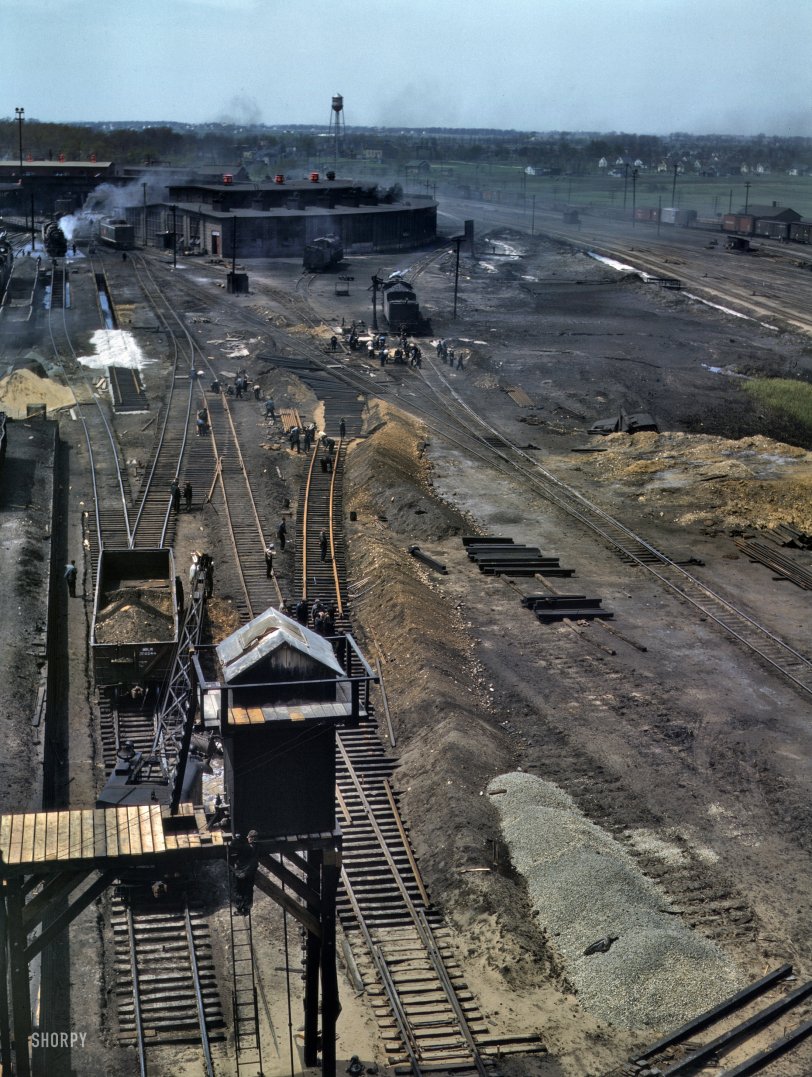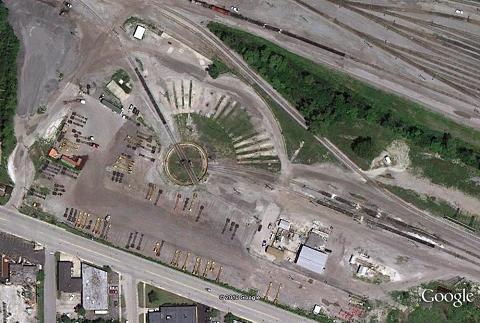


Framed or unframed, desk size to sofa size, printed by us in Arizona and Alabama since 2007. Explore now.
Shorpy is funded by you. Patreon contributors get an ad-free experience.
Learn more.

- Lost in Toyland
- And without gloves
- If I were a blindfolded time traveler
- Smoke Consumer Also Cooks
- Oh that stove!
- Possibly still there?
- What?!?
- $100 Reward
- Freeze Frame
- Texas Flyer wanted
- Just a Year Too Soon
- WWII -- Replacing men with women at the railroad crossing.
- Yes, Icing
- You kids drive me nuts!
- NOT An Easy Job
- I wonder
- Just add window boxes
- Icing Platform?
- Indiana Harbor Belt abides
- Freezing haze
- Corrections (for those who care)
- C&NW at Nelson
- Fallen Flags
- A dangerous job made worse
- Water Stop
- Passenger trains have right of way over freights?
- Coal
- Never ceases to amaze me.
- Still chuggin' (in model form)
- Great shot
Print Emporium
Bensenville: 1943

May 1943. Bensenville, Illinois. "Bensenville yard of the Chicago, Milwaukee, St. Paul, and Pacific Railroad. Track repair and work on the cinder pits at the roundhouse." 4x5 Kodachrome transparency by Jack Delano. View full size.
Remains of the Roundhouse
It appears this view is looking WNW. The roundhouse is gone, but you can still spot its remains (including the turntable) in aerial photography.
Coordinates 41°57'13.50"N, 87°55'54.58"W

Ash Pit 101
For Howdy and others -
On a coal-fired steam loco, the fuel is burned at the rear of the boiler in a large chamber known as the firebox. At its bottom is a large grate that actually holds the burning coal. Oxygen is drawn from below the firebox and through the grates for combustion.
Coal has many impurities such as sulfur, iron, ash, and dirt that only partially burn, producing cinders. Other impurities mix with oxygen then fuse with ash and dirt to produce a hard lump called a “clinker.” As the fuel burns, these waste products drop through the grates into an ashpan below.
The ashpan has to be emptied regularly, usually at every service stop and again at the end of each run, as the accumulation of cinders can restrict airflow to the point they greatly reduce efficiency, or in the worst case, actually extinguish the fire.
As the ash was still red-hot, it was typically emptied into a special holding area below the tracks – thus the "pit" in ash pit — lined with heat-resistant stone or firebrick. It was usually hosed down, but some larger terminals had water-filled pits to speed cooling.
A big terminal like Bensenville could easily generate well over 100 cubic yards of ash every day. Cinder was free and could be used like gravel, so it was reclaimed for a variety of jobs. The black material covering most of the area in the photo is cinder.
Robbie
Robbie Benson is still acting, doing voice-over work and directing. He has two projects "in development," if you know what I mean. There's a company that manufactures caskets in the form of classic cars in Bentonville, Arkansas. You can order Walnettos via the Internet, but neither Peter nor Paul are involved any longer. Hang in there.
White stuff
At first I would say it would be ballast, then again it looks like a huge pile of cocaine. Casey Jones better watch your speed!
As my daddy used to say:
"Get in the roundhouse Nellie...they can't corner you there." And also, as my ADD makes my mind wander, does anyone know what ever happened to Robbie Benson? And a similar sounding town, Bentonville, in Arkansas, is where Sam Walton opened his very first store. And does anyone remember Peter Paul Candy's Walnettos? Good night Gracie.
Coffee with cream and soot.
On the far right side of the photo, between the rail cars and the sliver of road, is a chimneyed structure. That building was a restaurant and bed stop for trainmen. I lived a few miles south of the rail yard in 1949 and ocassionally grabbed a late night sobering coffee on the way home.
Goings Ons
That looks like the side and roof of a locomotive cab over there on the right on the ground. Probably junk. I'll take it! Somebody spill something being soaked up by the white stuff? The 2nd engine and tender from the right appear to be on a section of track that no longer goes anywhere useful.
What's A Cinder Pit?
Page 63 has a cross section of the pit.
Stranded
The locomotive near the roundhouse wall seems to be stranded on an isolated section of track. Hope they don't need its services any time soon.
Inspiration
Photos like this create great inspiration for my model railroad. This is wonderful...thank you Dave
Uncle Clark is gone
But he'd probably have answers for the dozens of questions this photo raises. Not so many whos, but a big list of whys and whats. He was a railroad man for MoPac all his working life. One thing that I can guess is that most of those guys down there were probably "seasoned," meaning in 1943 there weren't too many young men around.
Close-by observation
I can smell the creosote and burning coal. As a kid I would be as close to all this action as I could possibly get. Only to go home, and due to the soil on my clothes, be told to stay away from those trains, it’s not safe! Great image.
























On Shorpy:
Today’s Top 5